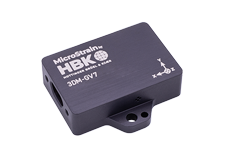FAQs
Videos
Yes, several time-stamps are available depending on the output including AHRS time-stamp, GPS synch time-stamp and GPS correlation time-stamp. The GPS time-stamp is available across all 3 datasets including NAV, GPS and IMU.
The connector is an MMCX type connector. The non-magnetic extension cable with SMA connector provided by LORD MicroStrain® must be used to isolate the magnetometers from magnetic connectors.
The 3DM-GX3-35® has a GPS direct mode to use the device in GPS only mode. This is compatible with existing NMEA and UBX applications.
No. There is no upgrade path.
Yes, it is easily done in software.
No. We do however have a Kalman filter on our 3DM-GX3-45 product.
Yes, several time stamps are available including AHRS time stamp, GPS synch time stamp and GPS correlation time stamp.
The wireless nodes all have 2 Mbytes of datalogging memory. This 2 Mbytes is organized into 8,191 ‘pages’ of memory, each page holds 132 data points. The maximum number of data points that can be held in memory can be calculated as follows: 8,191 pages x 132 data points/page = 1,081,212 total data points.
Now the question arises, ‘how long can a node datalog before its memory is full?’. The answer is that it varies depending on how many channels are being sampled and what sampling rate has been set. Here are two examples:
Let’s set a V-Link-LXRS so that channel 1 is active with a datalogging sampling rate of 2048 samples per second and we launch continuous datalogging. Our calculation would be:
- 1 channel x 2,048 samples per second = 2,048 data points per second
- 1,081,212 data points / 2,048 data points per second = 527 seconds
- 527 seconds / 60 seconds per minute = ~9 minutes to fill the memory
Let’s set a G-Link-LXRS so that channels 1, 2 and 3 are active with a datalogging sampling rate of 32 samples per second and we launch continuous datalogging. Our calculation would be:
- 3 channels x 32 samples per second = 96 data points per second
- 1,081,212 data points / 96 data points per second = 11,262 seconds
- 11,262 seconds / 60 seconds per minute = ~187 minutes to fill the memory
White papers are posted on: This page
In FINITE sampling, the user sets a total number of samples to be taken which equates to a time period. Because the sampling rate per second is known, the user can adjust the number of samples to be taken to determine how long the sampling period will be.
In CONTINUOUS sampling, the user does not set the total number of samples and therefore does not set the time of the sampling period. By selecting CONTINUOUS sampling, the user is instructing the system to sample data until the user manually stops the sampling (via software), the power is cycled, the on-board datalogging memory is full, the battery dies, the power fails, etc.










